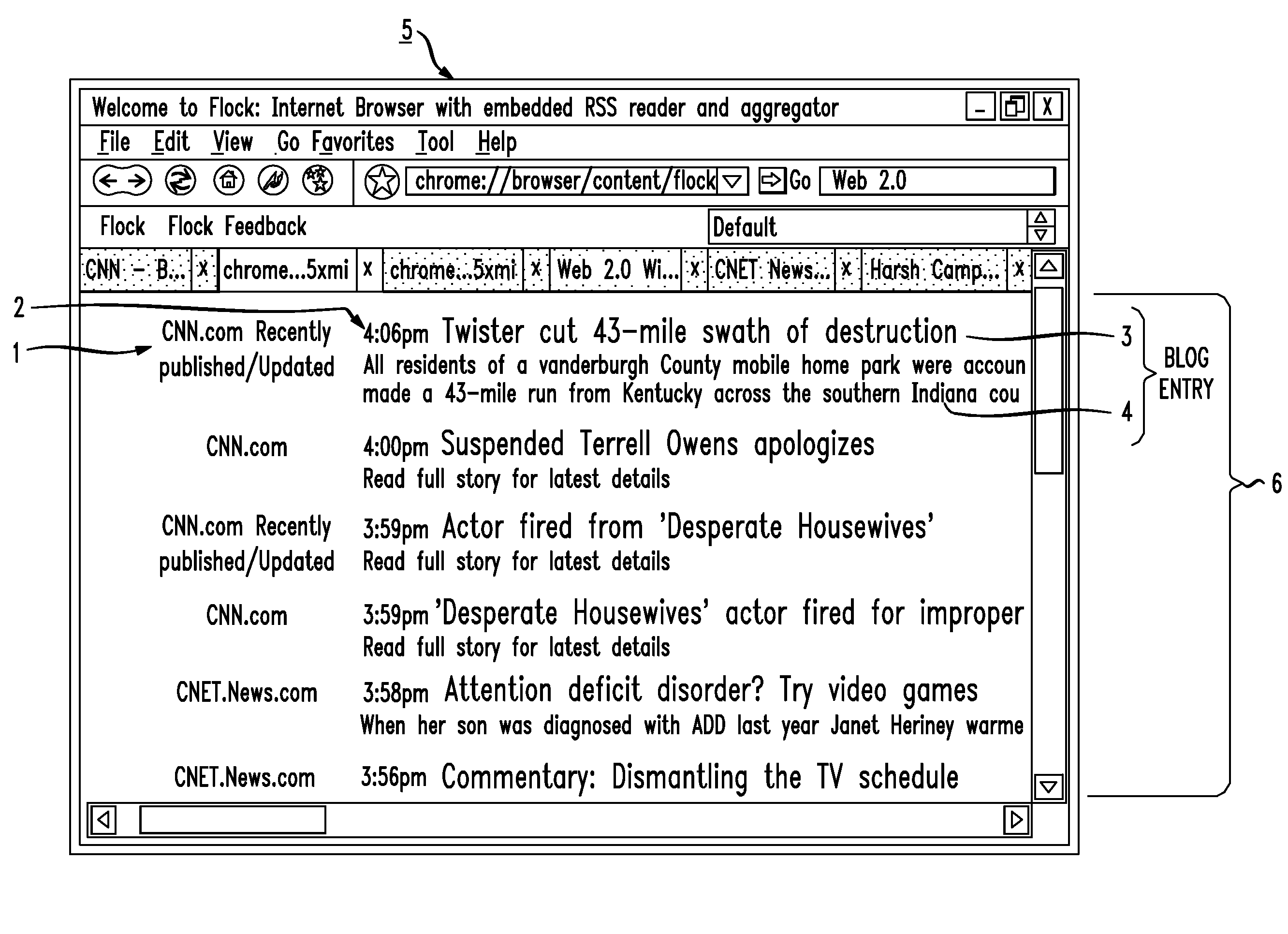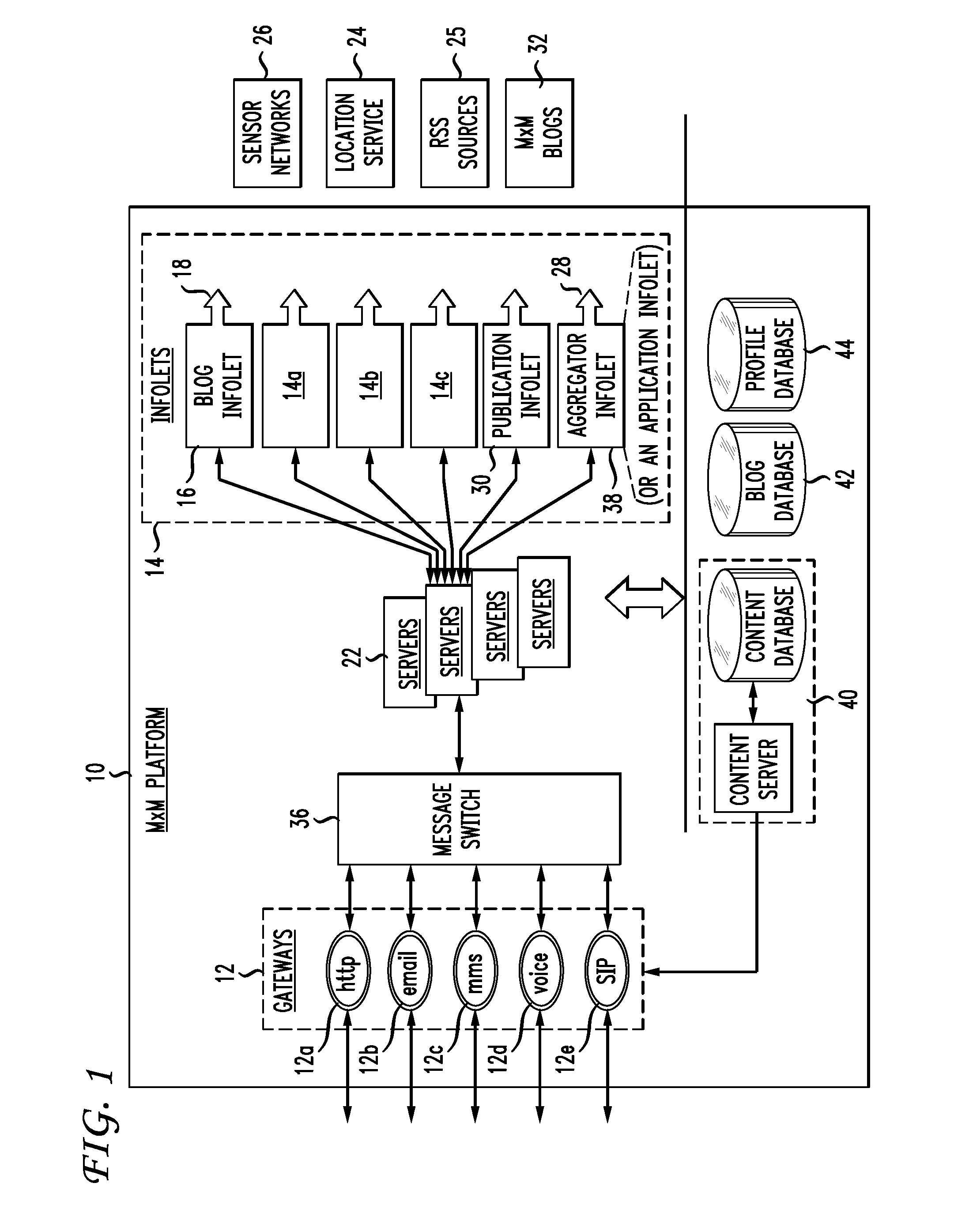Content dissemination using a multi-protocol converter
a multi-protocol converter and content technology, applied in the field of blogging, can solve the problems of many valuable information sources not yet available as or integrated with rss sources or other blogging tools, and achieve the effect of convenient storage and search
- Summary
- Abstract
- Description
- Claims
- Application Information
AI Technical Summary
Benefits of technology
Problems solved by technology
Method used
Image
Examples
example 1
An Internal Information Source a Blog, Information Sources Items, and Blog Items
[0049]blog descriptor[0050]attribute category of type string[0051]attribute frequency of type string (constrained to hourly, daily, weekly, monthly)[0052]blog item descriptor (a set of ‘description schema attributes’)[0053]attribute repairDate of type dateTime[0054]attribute repairLocation of type address[0055]attribute dealership of type string[0056]It should be noted that the exemplary set of types is defined by the service platform. The service platform also defines the ways to constrain types. For example, an attribute of type ‘string’ can be constrained by enumerating the set of allowed values. In the case of a blog, the set of attributes that make up the descriptor can be specified by the user when the blog is created. When an entry is posted to the blog, the user making the post will be queried to specify the values for each attribute part of the descriptor. The set of actual values make up the de...
example 2
Data from an External Information Source
[0065]Data from a non-RSS information source, such as, Exchange Server, calendar information. The descriptor of, for example, an RSS feed produced by an infolet handling information provided by the Exchange server is specified by the infolet.[0066]ExchangeCalendarInfolet item descriptor:[0067]Attribute priority of type string (constrained to low, medium, high)[0068]Attribute meeting of type boolean[0069]Attribute meetingLocation of type address[0070]For each calendar item, the infolet can ‘calculate’ the descriptive attributes from the available exchange calendar information (which is naturally richer information). When the infolet provides the RSS feed corresponding to a user's Exchange calendar information, the description is calculated and added to the feed:
poor repairpaid top $, got nothing donejorajora.autos.41Mon 10-Jan-2006 14:42:12Exchange calendarxmlns:calendar=“http: / / mxm.research.att.com / exchange / calendar”>lowtrueFlorhamPark,NJ
example 3
Data from an External RSS Feed
[0071]Data from an RSS information source, such as an External information source that is already available in RSS format can be enriched by calculating attributes from the existing information.[0072]Finance news feed item descriptor:[0073]Attribute company of type string[0074]Attribute stock of type string[0075]Attribute eventLocation of type address[0076]When the RSS infolet retrieves the feed, it analyzes the ‘description’ element of each item and looks for whatever seems to be the company name, and extracts it and places it in the description. From the company name, the RSS infolet can figure out the stock symbol for the company and can also add the stock symbol to the description. In a similar way, the event location could be found in the description or retrieved as the company's headquarters. The resulting feed is shown below:
GM Will Pay Lower Prices for Delphi Parts (AP) http: / / us.rd.yahoo.com / finance / news / rss / story / *http: / / us.rd.yahoo.com / fina...
PUM
 Login to View More
Login to View More Abstract
Description
Claims
Application Information
 Login to View More
Login to View More - R&D
- Intellectual Property
- Life Sciences
- Materials
- Tech Scout
- Unparalleled Data Quality
- Higher Quality Content
- 60% Fewer Hallucinations
Browse by: Latest US Patents, China's latest patents, Technical Efficacy Thesaurus, Application Domain, Technology Topic, Popular Technical Reports.
© 2025 PatSnap. All rights reserved.Legal|Privacy policy|Modern Slavery Act Transparency Statement|Sitemap|About US| Contact US: help@patsnap.com



